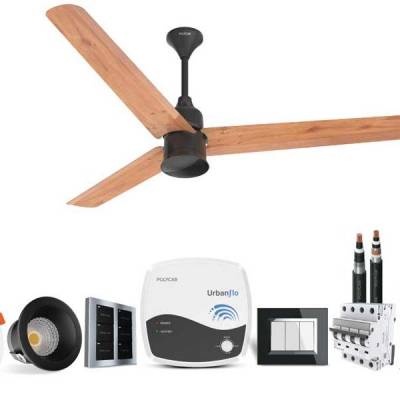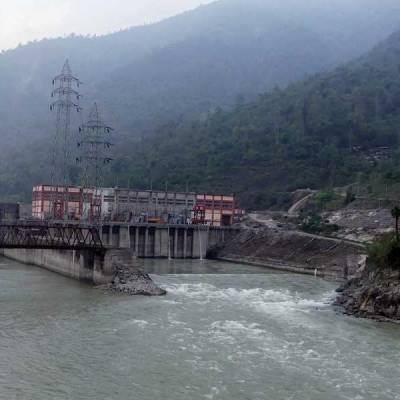- Home
- Infrastructure Energy
- POWER & RENEWABLE ENERGY
- Slick Sales

Slick Sales
One of the fastest growing lubricant industries globally, the Indian lube market is expected to grow at a CAGR of 11.5 per cent to $7,713 million by 2017, according to Ken Research. Automotive lubes dominate the market. Power, chemicals, metals and the mining industries are major users of industrial lubricants.
¨Steel and cement are big consumers of lubricants but the share of mining and construction exceeds these two segments if we consider only the plant consumption and eliminate the mining processes the former entail,¨ says Akhil Jha, Vice President Technical, Shell Lubricants India.
Changing market composition
By category, mineral oil-based lubricants dominate the market at present, with bio-based lubricants being the fastest growing market, according to Jha. However, he expects stringent emission and environmental norms to drive the adoption of leading-edge synthetic lubricants that provide energy-efficiency benefits and lower the total cost of ownership.
¨Synthetic oils have high drainage life and keep machinery in good health,¨ agrees Vidhushekhar, Manager-Purchase, Valecha Engineering Ltd. However, he says end-users, especially operators and mechanics, are not very conversant with the value additions of a good lubricant. ¨Also, biodegradable oils don´t harm the environment, but the construction industry has yet to give this fact some serious thought,¨ he adds.
As quality consciousness and overall awareness about the role of an appropriate and genuine lubricant in extending the life of parts are low, Jha believes a co-engineering approach between the lubricant company and hardware manufacturer would help approach emission control more comprehensively, and drive recognition, acceptance and demand for higher quality synthetic lubricants.
Cutting lube costs
Fuel cost, including expense on engine oil, has become a primary focus of the user industries. ¨Complying with tighter emission norms can help cut costs by cutting the consumption of oil,¨ says Jha. ¨So can effective after-treatment mechanisms.¨ Essentially, emission norms are driving advancement in engine design and technology, which in turn put a lot of stress on lubricants. Many conventional technology lubricants fail to meet these standards; higher specification engines need higher quality engine oils that can stay in grade for a longer period without causing problems like deposition and engine wear. Also, advanced engines and plants featuring compact and efficient hydraulic, gear and bearing oil systems require less lubricant. With this, the overall lube-to-fuel ratio improves.
¨It is a big positive that OEMs are working closely with lube companies in developing lubes that help them reduce emissions and contribute in regulations compliance,¨ observes Kaushik Madhavan, Head-Automotive & Transportation Practice, Frost & Sullivan. However, he believes the challenge lies in the aftermarket. ¨During service and periodical maintenance operations, customers don´t necessarily opt for the same lube that aids in emissions compliance. This is more pronounced in the independent aftermarket where price sensitivity is high and brand loyalty is not very strong.¨ ¨Identifying a good brand and right lubricant can also help save costs in the long run,¨ says Vidhushekhar. ¨The lubricant is the most derelict product in the construction industry except for some major corporations and entities. While all sorts of lubricants are readily available in India, the challenge is that lubricant suppliers are a dime a dozen and include major global players as well as fakes. Spurious products increase costs over time.¨
Lube per application Users are also increasingly fixated on productivity; to what extent can a lube boost outcomes?
¨Users of machines and heavy vehicles are increasingly looking for oils with proven anti-wear properties assuring exceptional equipment performance, fewer breakdowns and improved production capacity,¨ says Parveen S Khokher, Vice President, Cummins & Industrial, Valvoline Cummins Pvt Ltd.
Today´s lube market is fairly differentiated and high-end users are aware of the qualities of oils that make them more appropriate for specific applications. For instance, zinc-free hydraulic oils are considered force multipliers for excavators, especially in machines boasting compact hydraulic systems.
¨While zinc dialkyl dithio phosphates used to be extensively used in anti-wear hydraulic oils, increasingly compact hydraulic systems utilising high-service pressure pumps (>320kg per sq cm) create high operating temperatures (>2500°C) that have been shown to thermally degrade ZDDP into insoluble sludge,¨ explains Khokher. In contrast, zinc-free hydraulic oils exhibit outstanding high temperature performance providing an extra margin of equipment protection. ¨They also show excellent oxidation resistance and thermal stability characteristics, which assure exceptionally clean systems and trouble-free operation and extend the oil and filter change intervals, a key priority of equipment users nowadays,¨ he continues.
Limited-slip differentials are gaining ground among users of wheel loaders and heavy trucks. Khokher explains why: ¨Using a standard differential in off-road equipment situations where one wheel has no contact with the ground gives the non-contacting wheel all the power while the contacting wheel remains stationary. Then, equal torque is transmitted at both wheels, which does not exceed the threshold of torque needed to move the wheel with traction. A limited-slip differential prevents all the power from being allocated to one wheel, and thereby keeps both wheels in powered rotation.¨
Competitive marketplace
The Indian lube market is populated by domestic majors like Bharat Petroleum, Hindustan Petroleum and Indian Oil Corporation, and global companies like Shell, Valvoline Cummins, ExxonMobil, Total and others. Some equipment providers like Volvo also offer their own branded oils in competition to the oil companies. ¨Volvo´s presence in the lubricant business is more strategic in nature, driven primarily by the objective to enhance the equipment performance and component lifecycle, thereby reducing operating cost,¨ says Dimitrov Krishnan, Vice President, Volvo Construction Equipment India.
So while Volvo does not deny warranty nor insists on OEM certification in India for the use of commercial grade oil with defined API specifications, it does encourage and urge customers to use Volvo Oils for better performance and lower operating cost. ¨The bottom line, however, is that these are commercial grade oils and therefore may not necessarily meet up with all the performance metrics of Volvo Oils,¨ adds Krishnan.
Product performance-driven competition bodes well for users.
Quick Bytes
- Indian lube market is expected to grow at a CAGR of 11.5% to $7,713 million by 2017.
- Identifying a good brand and right lubricant can help save costs in the long run.
- Challenge: Lubricant suppliers are a dime a dozen and include major global players as well as fakes.
Used oil analysis for extended oil change intervals
Just as blood tests can reveal the status of human health, lubricant analysis offers insights into the health of equipment. By providing early warnings of any potential problems, used oil analysis can help ensure that machines perform optimally. Taking appropriate action, users can minimise the risk of damage to machines and unplanned downtime and achieve higher productivity.
¨Lubricant manufacturers are promoting the monitoring of oil samples and rightly so,¨ says Vidhushekhar, Manager-Purchase, Valecha Engineering Ltd. ¨Whereas the average oil change interval is 250 hours, nowadays equipment manufacturers have been able to extend it to 500 and some to even 1,000 hours, with better quality lubricant, periodic analysis of used oil and by introducing highly efficient filtration systems.¨
Lube-to-fuel ratio: What does it depend on?
¨Several factors bear upon this ratio, like engine design, engine age, type of lube, load conditions and driving conditions,¨ says Akhil Jha, Vice President- Technical, Shell Lubricants India.
Challenges of enhancing fuel-efficiency in off-highway situations
Regardless of challenges, methods exist to achieve higher fuel efficiency in off-highway situations. Akhil Jha, Vice President-Technical, Shell Lubricants India, explains the challenges and the breakthroughs:
- Off-highway equipment operates at low speeds, so minimising air resistance is not possible. Likewise, the equipment weight and rolling resistance of tires or tracks cannot be reduced owing to the need for traction.
- That leaves drive-line optimisation, by reducing power loss and optimising the engine´s load and speed conditions, as a means to increase efficiency. But oil undergoes higher levels of stress owing to drive-line optimisation.
- Another way to achieve fuel economy is by reducing frictional losses in engine hardware - in the valvetrain, the piston and cylinder, the oil pump and the crankshaft bearings. This is where engine oils like Shell GTL-based Rimula can help. Shell´s Rimula Series offers lower friction and better flow ability to cut losses and improve fuel efficiency.
Properties of advanced diesel engine oils
Advancing emission norms are driving evolution in diesel engine oils. One such oil is Valvoline Premium Blue 15 W 40 CI 4 Plus suitable for engines fitted with EGR and older varieties also. Based on its properties, Parveen S Khokher, Vice President, Cummins & Industrial, Valvoline Cummins Pvt Ltd, explains how users can make a sound judgment on which diesel engine oil to use by asking themselves a few important questions.
Does the oil boast of soot dispersant technology?
This technology keeps soot well-dispersed in the oil for a longer time, thus preventing viscosity increase owing to soot agglomeration, the blockage of oil filters and any associated drop in oil pressure.
Does the oil pass the high temperature corrosion bench test (HTCBT)?
Only lubricants that pass this test can prevent the corrosion of copper and lead components used in engine bearings.
Can the oil control deposit formation in the piston even under extreme driving conditions?
Modern low-emission engines run hotter than ever, which leads to accelerated deposit formation on the piston crown land, grooves and rings. This, in turn, can result in loss of power and high oil consumption.
Is the oil made of high-quality base oils?
Oils made from high-quality base oils possess high viscosity Index and excellent oxidation and thermal and chemical stability.
- Indian Lube Market
- Automotive Lubes
- Power
- Chemicals
- Metals
- Mining
- Akhil Jha
- Shell Lubricants India
- Vidhushekhar
- Valecha Engineering Ltd
- OEMs
- Kaushik Madhavan
- Frost & Sullivan
- Parveen S Khokher
- Valvoline Cummins Pvt Ltd
- Bharat Petroleum
- Hindustan Petroleum
- Indian Oil Corporation
- Shell
- ExxonMobil
- Dimitrov Krishnan
- Volvo Construction Equipment India
- HTCBT
Greater brand and product awareness would help grow the Indian lube market. One of the fastest growing lubricant industries globally, the Indian lube market is expected to grow at a CAGR of 11.5 per cent to $7,713 million by 2017, according to Ken Research. Automotive lubes dominate the market. Power, chemicals, metals and the mining industries are major users of industrial lubricants. ¨Steel and cement are big consumers of lubricants but the share of mining and construction exceeds these two segments if we consider only the plant consumption and eliminate the mining processes the former entail,¨ says Akhil Jha, Vice President Technical, Shell Lubricants India. Changing market composition By category, mineral oil-based lubricants dominate the market at present, with bio-based lubricants being the fastest growing market, according to Jha. However, he expects stringent emission and environmental norms to drive the adoption of leading-edge synthetic lubricants that provide energy-efficiency benefits and lower the total cost of ownership. ¨Synthetic oils have high drainage life and keep machinery in good health,¨ agrees Vidhushekhar, Manager-Purchase, Valecha Engineering Ltd. However, he says end-users, especially operators and mechanics, are not very conversant with the value additions of a good lubricant. ¨Also, biodegradable oils don´t harm the environment, but the construction industry has yet to give this fact some serious thought,¨ he adds. As quality consciousness and overall awareness about the role of an appropriate and genuine lubricant in extending the life of parts are low, Jha believes a co-engineering approach between the lubricant company and hardware manufacturer would help approach emission control more comprehensively, and drive recognition, acceptance and demand for higher quality synthetic lubricants. Cutting lube costs Fuel cost, including expense on engine oil, has become a primary focus of the user industries. ¨Complying with tighter emission norms can help cut costs by cutting the consumption of oil,¨ says Jha. ¨So can effective after-treatment mechanisms.¨ Essentially, emission norms are driving advancement in engine design and technology, which in turn put a lot of stress on lubricants. Many conventional technology lubricants fail to meet these standards; higher specification engines need higher quality engine oils that can stay in grade for a longer period without causing problems like deposition and engine wear. Also, advanced engines and plants featuring compact and efficient hydraulic, gear and bearing oil systems require less lubricant. With this, the overall lube-to-fuel ratio improves. ¨It is a big positive that OEMs are working closely with lube companies in developing lubes that help them reduce emissions and contribute in regulations compliance,¨ observes Kaushik Madhavan, Head-Automotive & Transportation Practice, Frost & Sullivan. However, he believes the challenge lies in the aftermarket. ¨During service and periodical maintenance operations, customers don´t necessarily opt for the same lube that aids in emissions compliance. This is more pronounced in the independent aftermarket where price sensitivity is high and brand loyalty is not very strong.¨ ¨Identifying a good brand and right lubricant can also help save costs in the long run,¨ says Vidhushekhar. ¨The lubricant is the most derelict product in the construction industry except for some major corporations and entities. While all sorts of lubricants are readily available in India, the challenge is that lubricant suppliers are a dime a dozen and include major global players as well as fakes. Spurious products increase costs over time.¨ Lube per application Users are also increasingly fixated on productivity; to what extent can a lube boost outcomes? ¨Users of machines and heavy vehicles are increasingly looking for oils with proven anti-wear properties assuring exceptional equipment performance, fewer breakdowns and improved production capacity,¨ says Parveen S Khokher, Vice President, Cummins & Industrial, Valvoline Cummins Pvt Ltd. Today´s lube market is fairly differentiated and high-end users are aware of the qualities of oils that make them more appropriate for specific applications. For instance, zinc-free hydraulic oils are considered force multipliers for excavators, especially in machines boasting compact hydraulic systems. ¨While zinc dialkyl dithio phosphates used to be extensively used in anti-wear hydraulic oils, increasingly compact hydraulic systems utilising high-service pressure pumps (>320kg per sq cm) create high operating temperatures (>2500°C) that have been shown to thermally degrade ZDDP into insoluble sludge,¨ explains Khokher. In contrast, zinc-free hydraulic oils exhibit outstanding high temperature performance providing an extra margin of equipment protection. ¨They also show excellent oxidation resistance and thermal stability characteristics, which assure exceptionally clean systems and trouble-free operation and extend the oil and filter change intervals, a key priority of equipment users nowadays,¨ he continues. Limited-slip differentials are gaining ground among users of wheel loaders and heavy trucks. Khokher explains why: ¨Using a standard differential in off-road equipment situations where one wheel has no contact with the ground gives the non-contacting wheel all the power while the contacting wheel remains stationary. Then, equal torque is transmitted at both wheels, which does not exceed the threshold of torque needed to move the wheel with traction. A limited-slip differential prevents all the power from being allocated to one wheel, and thereby keeps both wheels in powered rotation.¨ Competitive marketplace The Indian lube market is populated by domestic majors like Bharat Petroleum, Hindustan Petroleum and Indian Oil Corporation, and global companies like Shell, Valvoline Cummins, ExxonMobil, Total and others. Some equipment providers like Volvo also offer their own branded oils in competition to the oil companies. ¨Volvo´s presence in the lubricant business is more strategic in nature, driven primarily by the objective to enhance the equipment performance and component lifecycle, thereby reducing operating cost,¨ says Dimitrov Krishnan, Vice President, Volvo Construction Equipment India. So while Volvo does not deny warranty nor insists on OEM certification in India for the use of commercial grade oil with defined API specifications, it does encourage and urge customers to use Volvo Oils for better performance and lower operating cost. ¨The bottom line, however, is that these are commercial grade oils and therefore may not necessarily meet up with all the performance metrics of Volvo Oils,¨ adds Krishnan. Product performance-driven competition bodes well for users. Quick Bytes Indian lube market is expected to grow at a CAGR of 11.5% to $7,713 million by 2017. Identifying a good brand and right lubricant can help save costs in the long run. Challenge: Lubricant suppliers are a dime a dozen and include major global players as well as fakes. Used oil analysis for extended oil change intervals Just as blood tests can reveal the status of human health, lubricant analysis offers insights into the health of equipment. By providing early warnings of any potential problems, used oil analysis can help ensure that machines perform optimally. Taking appropriate action, users can minimise the risk of damage to machines and unplanned downtime and achieve higher productivity. ¨Lubricant manufacturers are promoting the monitoring of oil samples and rightly so,¨ says Vidhushekhar, Manager-Purchase, Valecha Engineering Ltd. ¨Whereas the average oil change interval is 250 hours, nowadays equipment manufacturers have been able to extend it to 500 and some to even 1,000 hours, with better quality lubricant, periodic analysis of used oil and by introducing highly efficient filtration systems.¨ Lube-to-fuel ratio: What does it depend on? ¨Several factors bear upon this ratio, like engine design, engine age, type of lube, load conditions and driving conditions,¨ says Akhil Jha, Vice President- Technical, Shell Lubricants India. Challenges of enhancing fuel-efficiency in off-highway situations Regardless of challenges, methods exist to achieve higher fuel efficiency in off-highway situations. Akhil Jha, Vice President-Technical, Shell Lubricants India, explains the challenges and the breakthroughs: Off-highway equipment operates at low speeds, so minimising air resistance is not possible. Likewise, the equipment weight and rolling resistance of tires or tracks cannot be reduced owing to the need for traction. That leaves drive-line optimisation, by reducing power loss and optimising the engine´s load and speed conditions, as a means to increase efficiency. But oil undergoes higher levels of stress owing to drive-line optimisation. Another way to achieve fuel economy is by reducing frictional losses in engine hardware - in the valvetrain, the piston and cylinder, the oil pump and the crankshaft bearings. This is where engine oils like Shell GTL-based Rimula can help. Shell´s Rimula Series offers lower friction and better flow ability to cut losses and improve fuel efficiency. Properties of advanced diesel engine oils Advancing emission norms are driving evolution in diesel engine oils. One such oil is Valvoline Premium Blue 15 W 40 CI 4 Plus suitable for engines fitted with EGR and older varieties also. Based on its properties, Parveen S Khokher, Vice President, Cummins & Industrial, Valvoline Cummins Pvt Ltd, explains how users can make a sound judgment on which diesel engine oil to use by asking themselves a few important questions. Does the oil boast of soot dispersant technology? This technology keeps soot well-dispersed in the oil for a longer time, thus preventing viscosity increase owing to soot agglomeration, the blockage of oil filters and any associated drop in oil pressure. Does the oil pass the high temperature corrosion bench test (HTCBT)? Only lubricants that pass this test can prevent the corrosion of copper and lead components used in engine bearings. Can the oil control deposit formation in the piston even under extreme driving conditions? Modern low-emission engines run hotter than ever, which leads to accelerated deposit formation on the piston crown land, grooves and rings. This, in turn, can result in loss of power and high oil consumption. Is the oil made of high-quality base oils? Oils made from high-quality base oils possess high viscosity Index and excellent oxidation and thermal and chemical stability.




















